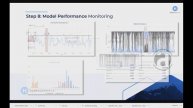How to get a grip on your microservices using a service mesh
Many organizations are now building microservices based systems. But with the adoption of this architecture-style, the need arises for a good way to control and monitor all the services and their traffic. To handle this, you can leverage what is called a service mesh.
In this session Edwin van Wijk from Info Support introduces the service mesh concept and shows you how to implement a service mesh for your microservices based system using open-source tools Docker, Kubernetes and Istio. After a short introduction of the concepts and tools, Edwin shows several service mesh capabilities in a series of demos.
00:00:09 Introduction
00:01:11 Docker containers recap
00:01:53 Kubernetes 101
00:08:45 Introduction of the Pitstop demo application
00:11:04 Looking at a Kubernetes configuration file
00:14:11 Deploying the demo app on the Kubernetes cluster
00:15:35 Inspecting the running application in the Kubernetes Dashboard
00:17:29 Demo of the Pitstop application
00:18:32 Introduction of the service mesh concept
00:21:12 Introduction of Istio
00:23:33 Looking at an Istio enriched configuration file
00:24:55 Istio Monitoring
00:27:37 Scaling pods
00:28:09 Deploying a second version of a microservice
00:29:36 Dark releasing the new version using traffic mirroring
00:34:13 Canary releasing the new version using weighted load-balancing
00:36:27 Do chaos engineering by injecting faults
00:39:36 Wrap up and links to some handy resources
If you want to get the code shown in de video, check out the Github repo at: https://github.com/edwinvw/pitstop.
This video was made possible by Info Support (https://www.infosupport.com) and DotNed, the Dutch .NET Usergroup (https://www.dotned.nl).
--
Видео How to get a grip on your microservices using a service mesh автора Python мастерская
Видео How to get a grip on your microservices using a service mesh автора Python мастерская
Информация
4 декабря 2023 г. 3:29:32
00:41:17
Похожие видео
 Anweisungen zur Reinigung Deiner Panama-Jack-Stiefeln in Goretex
Anweisungen zur Reinigung Deiner Panama-Jack-Stiefeln in Goretex 04. Типы Информационных систем. Составляющие ИС
04. Типы Информационных систем. Составляющие ИС Longhorn: Intro, Deep Dive and Q+A - David Ko & Shuo Wu, SUSE
Longhorn: Intro, Deep Dive and Q+A - David Ko & Shuo Wu, SUSE Клубы мышления как интеллектуальный ресурс
Клубы мышления как интеллектуальный ресурс Как все буквы сделать маленькими в ворде
Как все буквы сделать маленькими в ворде Как сделать жирную линию в Ворде
Как сделать жирную линию в Ворде Helping One of Europe's Banks Re-platform with Declarative, Self-hea... Stuart Harris & Aayush Attr
Helping One of Europe's Banks Re-platform with Declarative, Self-hea... Stuart Harris & Aayush Attr Сборка 3д принтеров
Сборка 3д принтеров Demo of Daily Sales Record automation using Apache Camel
Demo of Daily Sales Record automation using Apache Camel Armo Kubescape offline support
Armo Kubescape offline support Infinix Smart 6 HD X6512 разблокировка удаление FRP Unlocktool
Infinix Smart 6 HD X6512 FRP
Infinix Smart 6 HD X6512 разблокировка удаление FRP Unlocktool
Infinix Smart 6 HD X6512 FRP Kubeflow and Beyond: Automation of Model Training, Deployment and Testing
Kubeflow and Beyond: Automation of Model Training, Deployment and Testing A New Secure Container Solution on Arm Platform: gVisor - Bin Lu, Arm
A New Secure Container Solution on Arm Platform: gVisor - Bin Lu, Arm Как сделать обтекание картинки текстом в ворде
Как сделать обтекание картинки текстом в ворде 1. What is Diatonic
1. What is Diatonic Как в ворде поставить цифру над словом
Как в ворде поставить цифру над словом Как двигать картинку в Ворде
Как двигать картинку в Ворде Никита Осипенко - сисадмин и диджей
Никита Осипенко - сисадмин и диджей Keep log file size fixed without logrotate (6 Solutions!!)
Keep log file size fixed without logrotate (6 Solutions!!) ТАНЕЦ С САБЛЕЙ - на день МВД
ТАНЕЦ С САБЛЕЙ - на день МВД
